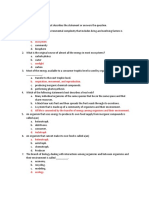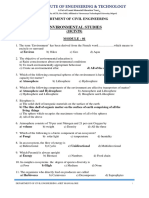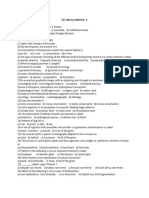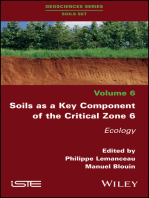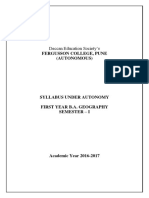EST Assignment 3
Uploaded by
dilipnawale27EST Assignment 3
Uploaded by
dilipnawale27JSPM’S
BHIVARABAI SAWANT POLYTECHNIC,
Wagholi, Pune- 412207.
ASSIGNMENT NO: 3
(Academic Year 2024-25)
Sub: - Environmental Studies Subject Code: -22447
Semester: 05 Chapter : 3
Sr. MCQ’s
No
1. Which one of the following is not a gaseous biogeochemical cycle in an ecosystem?
a) Carbon cycle b) Phosphorous cycle c) Sulfur cycle d) Nitrogen cycle
2. Transfer of energy from source of plants through a series of organism is known as ________________
a) Food web b) Energy cycle c) Food chain d) Biological system
3. The type of ecosystem with the highest mean plant productivity is _______________
a) Tundra b) Temperate grassland c) Desert d) Tropical rain forest
4. An ecosystem which can be easily damaged but can recovered after some time if damaging effect stops
will be having ____________________
a) High stability and high resilience b) High stability and low resilience
c) Low stability and low resilience d) Low stability and high resilience
5. In ecosystem standing crop refers to________________
a) All the green plants
b) All the non living materials
c) All living and dead animals
d) All the living materials both animals and plants
6. Which ecosystem produces the highest annual net primary productivity?
a) Tropical evergreen forest b) Tropical rain forest
c) Tropical deciduous forest d) Temperate evergreen forest
7. What flows through the ecosystem while matter cycles within them?
a) Energy b) Force c) Pressure d) Wind
8. Total primary production in an ecosystem is known as____________________
a) Gross final production b) Gross primary production
c) Gross middle production d) Net primary production
9. Which type of ecosystem accounts for most of the net primary productivity on earth even though it has a
low average net primary productivity?
a) Tropical rain forest b) Desert c) Tropical evergreen forest d) Oceans
10. Generally ecosystem consists of how many basic components?
a) One b) Two c) Three d) Four
11. The three functional components interact with each other to form__________________
a) Environmental succession b) Environmental depression
c) Environmental system d) Ecology
12. Consumer for food that feeds on producers are known as_____________________
a) Carnivores b) Consumers c) Herbivores d) Producers
13. The food chain from grass to hawk and again it comes back to grass with the help of fungi. In the above
explain food chain, what is grass?
a) Producers b) Consumers c) Decomposers d) Energy source
14. The process in which green plants and few organisms use sunlight to synthesize nutrients is
known_________________
a) Chemosynthesis b) Photosynthesis c) Food chain d) Food web
15. The process of making food by certain microbes create energy by some chemical reactions is known
as_______________________
a) Photosynthesis b) Food chain c) Chemosynthesis d) Hetrosynthesis
16. The food chain level in autotrophy is_____________
a) Primary b) Secondary c) Tertiary d) Quaternary
17. What are the species called whose number of individuals is greatly reduced recently and is decreasing
continuously?
a) Endangered b) Rare c) Vulnerable d) Indeterminate
18. How many species of plants contribute to the traditional medicines used by native peoples around the
world?
a) 2,500 b) 2,000 c) 5,000 d) 25,000
19. How many plant and animal species have been discovered and described so far?
a) 1.5 million b) 4.5 million c) 1.5 billion d) 4.5 billion
20. How much of the world’s land area, India has?
a) 1 percent b) 40 percent c) 2.4 percent d) 80 percent
You might also like
- Instant ebooks textbook (eBook PDF) Geosystems An Introduction to Physical Geography, Updated Fourth Canadian Edition download all chapters100% (4)Instant ebooks textbook (eBook PDF) Geosystems An Introduction to Physical Geography, Updated Fourth Canadian Edition download all chapters34 pages
- Ecosystem: Structure and Function MCQ (Multiple Choice Questions and Answers)100% (2)Ecosystem: Structure and Function MCQ (Multiple Choice Questions and Answers)18 pages
- Science of The Total Environment: Soil Microbial Biomass: A Key Soil Driver in Management of Ecosystem FunctioningNo ratings yetScience of The Total Environment: Soil Microbial Biomass: A Key Soil Driver in Management of Ecosystem Functioning5 pages
- Worksheet Ix Ecology Nsejs 230420 213848No ratings yetWorksheet Ix Ecology Nsejs 230420 2138485 pages
- All Units Short, Essay, Multiple Choice .ES 22.02.17No ratings yetAll Units Short, Essay, Multiple Choice .ES 22.02.17152 pages
- Worksheet Ix Ecology Nsejs-1 230420 213823No ratings yetWorksheet Ix Ecology Nsejs-1 230420 2138239 pages
- 61093f8d0cfe2c00182cf286 ## Practice Sheet-1 Umeed Batch Ecosystem Q51 (03!08!2021) Biswajit Sir Mohit DTPNo ratings yet61093f8d0cfe2c00182cf286 ## Practice Sheet-1 Umeed Batch Ecosystem Q51 (03!08!2021) Biswajit Sir Mohit DTP6 pages
- O Level Biology Practice Questions And Answers: Ecology And Our Impact On The EcosystemFrom EverandO Level Biology Practice Questions And Answers: Ecology And Our Impact On The EcosystemNo ratings yet
- Soils as a Key Component of the Critical Zone 6: EcologyFrom EverandSoils as a Key Component of the Critical Zone 6: EcologyPhilippe LemanceauNo ratings yet
- The Environment Principles and Applications 2nd Edition Chris Park 2024 scribd download100% (7)The Environment Principles and Applications 2nd Edition Chris Park 2024 scribd download67 pages
- Pakistan International School (English Section) : Scheme of Studies (1 Term) Session 2020-2021No ratings yetPakistan International School (English Section) : Scheme of Studies (1 Term) Session 2020-20212 pages
- 1 Describe The Distribution of Active Volcanoes, Earthquake Epicenters and Major Mountain BeltsNo ratings yet1 Describe The Distribution of Active Volcanoes, Earthquake Epicenters and Major Mountain Belts3 pages
- SCI-10 Q1 Mod-6 ProcLandformsDivergent V3bNo ratings yetSCI-10 Q1 Mod-6 ProcLandformsDivergent V3b16 pages
- A Ten Years Hail Climatology Based On ESWD Hail Reports in Romania-V2.0-english - RevisedNo ratings yetA Ten Years Hail Climatology Based On ESWD Hail Reports in Romania-V2.0-english - Revised10 pages



























